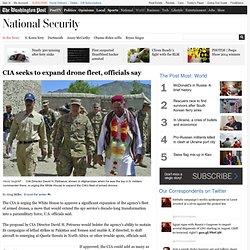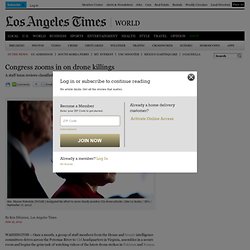

CIA seeks to expand drone fleet, officials say. If approved, the CIA could add as many as 10 drones, the officials said, to an inventory that has ranged between 30 and 35 over the past few years.

The outcome has broad implications for counterterrorism policy and whether the CIA gradually returns to being an organization focused mainly on gathering intelligence, or remains a central player in the targeted killing of terrorism suspects abroad. The Rizzo Investigation. Marc Ambinder and Yochi Dreazen report in the : The Justice Department is investigating whether a former top U.S. intelligence official, John Rizzo, improperly disclosed classified information about the CIA’s drone campaign, one of the spy agency’s most secretive and politically sensitive programs.
People familiar with the matter say that the CIA’s general counsel’s office opened the probe in March, shortly after Newsweek published an article in which Rizzo — who had retired in 2009 after serving as the CIA’s acting general counsel — outlined an array of specific details about how CIA officials choose terrorists for drone strikes and which American officials sign off on actually carrying them out. The CIA’s decision to launch a leak probe targeting a long-time employee who served as its highest legal officer is significant on at least two fronts.
Congress zooms in on drone killings. WASHINGTON -- Once a month, a group of staff members from the House and Senate intelligence committees drives across the Potomac River to CIA headquarters in Virginia, assembles in a secure room and begins the grim task of watching videos of the latest drone strikes in Pakistan and Yemen.

Sometimes they see Hellfire missiles hit buildings after suspected terrorists have entered. Other times they can make out a group or a vehicle consumed in a fiery blast. Occasionally, a smaller explosion kills just one person, as officials say happened when a missile this month crashed into a room in Pakistan's tribal areas and killed Abu Yahya al Libi, Al Qaeda's No. 2. The videos are much sharper than the grainy drone imagery that can be viewed on the Web. "You can see exactly what is going on," said a senior congressional aide, who, like other officials, spoke about the highly classified program on the condition he not be identified.
Feinstein did not respond to requests last week for an interview. The CIA's unchecked quasi-military role - POLITICO.com Print View. Revelations of a foiled airplane bomb this week reinforced the CIA’s old Hollywood image: a slick spy agency adept at thwarting international plots.

But the agency is more than this espionage fantasy. It is quietly transforming into a de facto branch of the armed forces — while still operating outside public scrutiny. Drone strikes have turned the CIA into a war-fighter. The agency does not just provide intelligence, it decides when to pull the drone trigger. Continue Reading The public and policymakers need to understand that the CIA’s drones are not just aimed at a few Al Qaeda leaders. Though the CIA often works alongside the U.S. military — as in last year’s raid that killed Osama bin Laden — it is fundamentally different and its role in drone strikes marks a new chapter. The agency was initially reluctant to conduct drone strikes and “make what it viewed as largely military decisions,” according to a 2001 New York Times report.
How the CIA Became the 6th Branch of the Military. Robert Wright, in an obvious effort to use Petraeusgate to draw attention to a boring subject that has nothing to do with sex, says the real scandal here isn't Petraeus leaving the CIA, it's the fact that he arrived there in the first place: When, in the fall of 2011, David Petraeus moved from commanding the Afghanistan war effort to commanding the CIA, it was a disturbingly natural transition.

I say "natural" because the CIA conducts drone strikes in the Afghanistan-Pakistan region and is involved in other military operations there, so Petraeus, in his new role, was continuing to fight the Afghanistan war. I say "disturbingly" because this overlap of Pentagon and CIA missions is the result of a creeping militarization of the CIA that may be undermining America's national security.The militarization of the CIA raises various questions. As near as I can tell, drone warfare was largely handed over to the CIA precisely in order to avoid normal military accountability. C.I.A. Steps Up Drone Attacks on Taliban in Pakistan. The risks of the C.I.A.’s Predator drones. On August 5th, officials at the Central Intelligence Agency, in Langley, Virginia, watched a live video feed relaying closeup footage of one of the most wanted terrorists in Pakistan.

Baitullah Mehsud, the leader of the Taliban in Pakistan, could be seen reclining on the rooftop of his father-in-law’s house, in Zanghara, a hamlet in South Waziristan. It was a hot summer night, and he was joined outside by his wife and his uncle, a medic; at one point, the remarkably crisp images showed that Mehsud, who suffered from diabetes and a kidney ailment, was receiving an intravenous drip.
The video was being captured by the infrared camera of a Predator drone, a remotely controlled, unmanned plane that had been hovering, undetected, two miles or so above the house. Pakistan’s Interior Minister, A. Rehman Malik, told me recently that Mehsud was resting on his back. The U.S. government runs two drone programs. Nevertheless, reports of fatal air strikes in Pakistan emerge every few days.